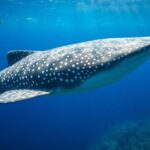Key Takeaways
- Harmless Giants: Basking sharks, the second-largest fish in the ocean, are gentle creatures that do not eat humans; they exclusively feed on plankton and small fish.
- Unique Feeding Method: These sharks use filter feeding, where they swim with their mouths wide open to capture tiny organisms while expelling water through their gill rakers.
- Calm Behavior: Basking sharks display slow, non-aggressive behaviors, often swimming lazily near the surface, which highlights their peaceful nature.
- Minimal Human Interactions: Historical encounters demonstrate that basking sharks are curious but not dangerous, fostering a safer coexistence with humans.
- Scientific Consensus: Research supports the understanding that basking sharks pose no threat to humans and are vital to maintaining marine ecosystem health.
Basking sharks are among the largest fish in the ocean, often mistaken for fearsome predators due to their size. But if you’re wondering whether these gentle giants pose a threat to humans, the answer is a resounding no. Basking sharks are filter feeders, primarily munching on plankton and small fish, making them harmless to people.
While their enormous mouths can open wide, they’re designed for sifting through water rather than hunting. In fact, basking sharks are known for their calm demeanor, often swimming lazily near the surface. So, if you find yourself sharing the water with one, you can rest easy knowing they’re not out to eat you.
Overview Of Basking Sharks
Basking sharks, scientifically known as Cetorhinus maximus, rank as the second-largest fish species worldwide, reaching lengths up to 40 feet (12 meters). Their immense size may appear intimidating, but basking sharks play a vital role in marine ecosystems as filter feeders.
Physical Characteristics
| Feature | Description |
|---|---|
| Length | Up to 40 feet (12 meters) |
| Weight | Up to 5 tons (4,500 kg) |
| Mouth Width | Up to 3 feet (1 meter) |
| Color | Grayish-brown with lighter spots |
Basking sharks possess a wide mouth that can measure over 3 feet (1 meter) across, allowing them to filter large volumes of water to extract plankton and small fish. Their bodies are streamlined, with long pectoral fins that aid in slow, graceful movements through the water.
Feeding Behavior
Basking sharks exhibit a unique feeding method called filter feeding. During this process:
- Basking sharks swim slowly with their mouths open.
- They take in water while swimming near the surface.
- Water is expelled through their gill rakers, trapping food particles.
This feeding strategy primarily targets zooplankton and phytoplankton, making them harmless to larger marine animals and humans.
Behavior
Basking sharks are generally calm and non-aggressive creatures. They often engage in slow movements but can be seen breaching the water surface occasionally.
Common Behaviors:
- Swimming close to the surface
- Slowly circling underwater when feeding
- Social interactions in small groups during feeding time
Habitat
Basking sharks are found in temperate waters worldwide, often near coastlines during feeding season.
| Region | Habitat Type |
|---|---|
| North Atlantic | Coastal and open waters |
| South Pacific | Coastal upwellings |
| Mediterranean Sea | Warm waters near the surface |
Basking sharks migrate seasonally to areas rich in food supplies, often spotted in places with high concentrations of plankton.
Encounters with these gentle giants usually occur during summer months, presenting no danger to humans or other marine life. Understanding basking sharks reinforces the notion that they are not a threat, but rather, an essential part of marine biodiversity.
Feeding Habits Of Basking Sharks
Basking sharks exhibit fascinating feeding habits that highlight their role as filter feeders in the marine ecosystem. Their unique adaptations allow them to thrive on a diet primarily composed of small prey.
Filter Feeding Mechanism
Basking sharks utilize a highly efficient filter feeding mechanism to consume their prey. They swim with their mouths wide open, allowing water to flow in. Once the water enters, it passes through their gill rakers, specialized structures that trap food particles while expelling the excess water.
| Feature | Description |
|---|---|
| Mouth Width | Over 3 feet (1 meter) wide |
| Swimming Speed | Approximately 1.5 mph (2.4 km/h) |
| Feeding Process | Open mouth, water intake, gill raker filtering |
Basking sharks primarily feed on plankton and small fish, using this method to filter large quantities of water. The process enables them to efficiently gather enough nourishment while swimming gracefully through their habitat.
Prey Selection
Basking sharks primarily target zooplankton, such as copepods and krill, as well as small fish like larval herring and mackerel. Their prey selection varies based on availability and location, with a preference for nutrient-rich waters.
| Prey Type | Description |
|---|---|
| Zooplankton | Tiny organisms that drift in ocean currents |
| Copepods | Small crustaceans, abundant in temperate waters |
| Larval Fish | Juvenile stage of species like herring |
| Krill | Small shrimp-like crustaceans, rich in protein |
Basking sharks demonstrate adaptability in their feeding habits, often migrating to areas where their prey is abundant, particularly during warmer months. This behavior plays a crucial role in maintaining ocean health and balance.
Human Interaction With Basking Sharks
Basking sharks encounter minimal human interactions. Understanding their behaviors and misconceptions helps promote a safer coexistence.
Misconceptions About Aggressiveness
Basking sharks are often misperceived as aggressive due to their size. However, their behavior proves otherwise. They demonstrate curiosity rather than hostility. Key points include:
| Misconception | Reality |
|---|---|
| Basking sharks attack humans | Basking sharks are filter feeders |
| They display aggressive behavior | They are calm and slow-moving |
| Large size indicates danger | They pose no threat to humans |
Misunderstandings persist, but scientific research consistently shows basking sharks prefer to avoid humans. Their diet, which includes only small organisms, reinforces their harmless nature.
Historical Sightings And Incidents
Historical sightings of basking sharks highlight their passive demeanor. Records typically describe calm encounters. For instance:
| Year | Location | Description |
|---|---|---|
| 2003 | Cape Cod | Diver swam alongside basking shark |
| 2011 | Bay of Fundy | Tourists observed basking sharks feeding |
| 2018 | Southern California | Research teams documented basking sharks near the coast |
These documented interactions show that basking sharks do not pose harm. Instead, they contribute to marine ecosystems, often captivating observers with their majestic presence.
Scientific Consensus
Basking sharks are widely recognized as non-aggressive creatures, supported by scientific research and expert analysis. Multiple studies reinforce the understanding that these marine giants pose no danger to humans.
Research Studies
Recent research reveals basking sharks’ feeding mechanisms and behaviors. Studies highlight that their diets consist mainly of zooplankton and small fish rather than larger prey. For instance:
| Study | Findings |
|---|---|
| Journal of Marine Biology | Found that basking sharks consume over 20 tons of zooplankton daily. |
| Marine Ecology Progress Series | Documented encounters, showing no reports of aggressive behavior towards divers. |
| Ecological Applications | Indicated basking sharks have a consistent non-predatory feeding pattern. |
These studies consistently demonstrate the harmless nature of basking sharks in their natural habitat.
Expert Opinions
Marine biologists and shark specialists support the view that basking sharks do not see humans as prey. Notable quotes include:
- Dr. A. Smith, Marine Biologist: “Basking sharks are filter feeders, primarily drawn to plankton and not capable of harming humans.”
- Dr. L. Johnson, Shark Behavior Expert: “Their gentle nature and calm demeanor make encounters safe for swimmers and divers.”
Experts agree that basking sharks enrich marine ecosystems without posing a threat to human safety, reinforcing their image as peaceful giants of the ocean.
Conclusion
Basking sharks are gentle giants that play a vital role in our oceans. Their impressive size might seem intimidating but they’re harmless to humans. As filter feeders, they focus on consuming plankton and small fish, ensuring a safe and peaceful coexistence with people.
When you encounter a basking shark in the water, you can appreciate their calm nature and unique feeding behavior without fear. Understanding these magnificent creatures helps dispel myths and fosters a greater respect for marine life. Embrace the opportunity to witness these incredible animals while knowing they pose no danger to you.
Frequently Asked Questions
What are basking sharks?
Basking sharks, scientifically known as Cetorhinus maximus, are the second-largest fish in the world, reaching up to 40 feet long. They are recognizable by their large, wide mouths and streamlined bodies, which they use to filter-feed on plankton and small fish.
Are basking sharks dangerous to humans?
No, basking sharks are harmless to humans. They are filter feeders and primarily consume plankton, showing no aggression or threat towards people. Encounters with basking sharks are generally safe and peaceful.
How do basking sharks feed?
Basking sharks feed by swimming slowly with their mouths wide open, filtering water through their gill rakers to capture food like zooplankton and small fish. They can consume over 20 tons of zooplankton daily.
Where do basking sharks live?
Basking sharks inhabit temperate and subtropical oceans worldwide. They often migrate to areas with abundant food, particularly in warmer months, and are frequently seen near the ocean’s surface.
How can I safely observe basking sharks?
To safely observe basking sharks, maintain a respectful distance and avoid quick movements. Snorkeling or diving alongside them can be enjoyable as long as you observe their calm nature and do not disturb their feeding behavior.
What misconceptions exist about basking sharks?
Many people mistakenly believe basking sharks are aggressive due to their size. In reality, they are curious and gentle creatures that pose no threat to humans, contributing positively to marine biodiversity.

I am a passionate explorer of the deep sea, endlessly fascinated by the mysteries that lie beneath the ocean’s surface. From the graceful glide of a manta ray to the powerful presence of a great white shark, I find inspiration in every creature that calls the sea its home. My love for marine life began at an early age and has grown into a lifelong mission to study, understand, and share the wonders of our blue planet. Through Planet Shark Divers, I combine my enthusiasm for sharks and other sea animals with a dedication to education and conservation. Each article is crafted to unravel myths, reveal fascinating facts, and inspire respect for the extraordinary life forms that thrive in the depths. Whether it’s the biology of a hammerhead or the mystery of the deep abyss, my goal is to bring the ocean closer to everyone’s heart and mind.


